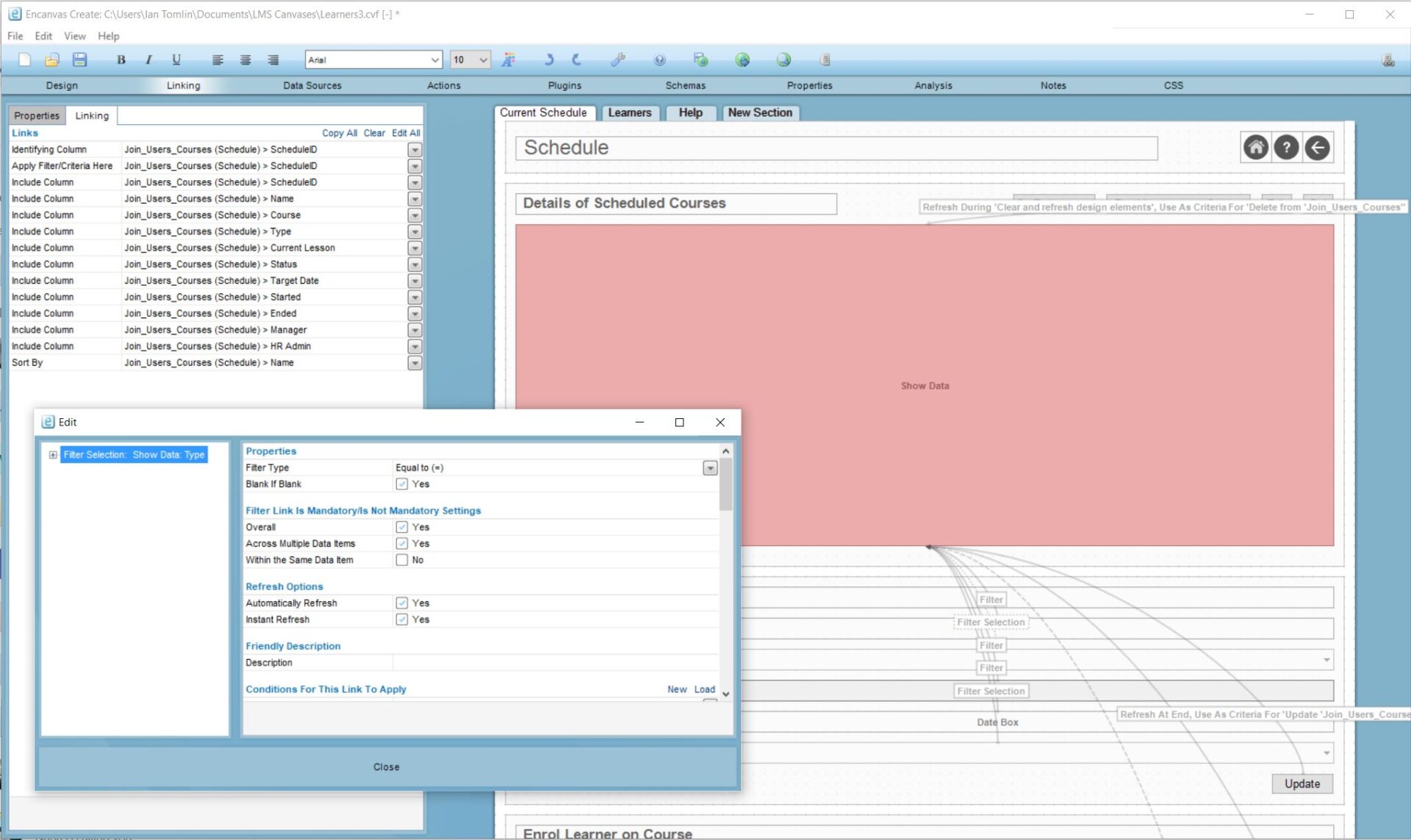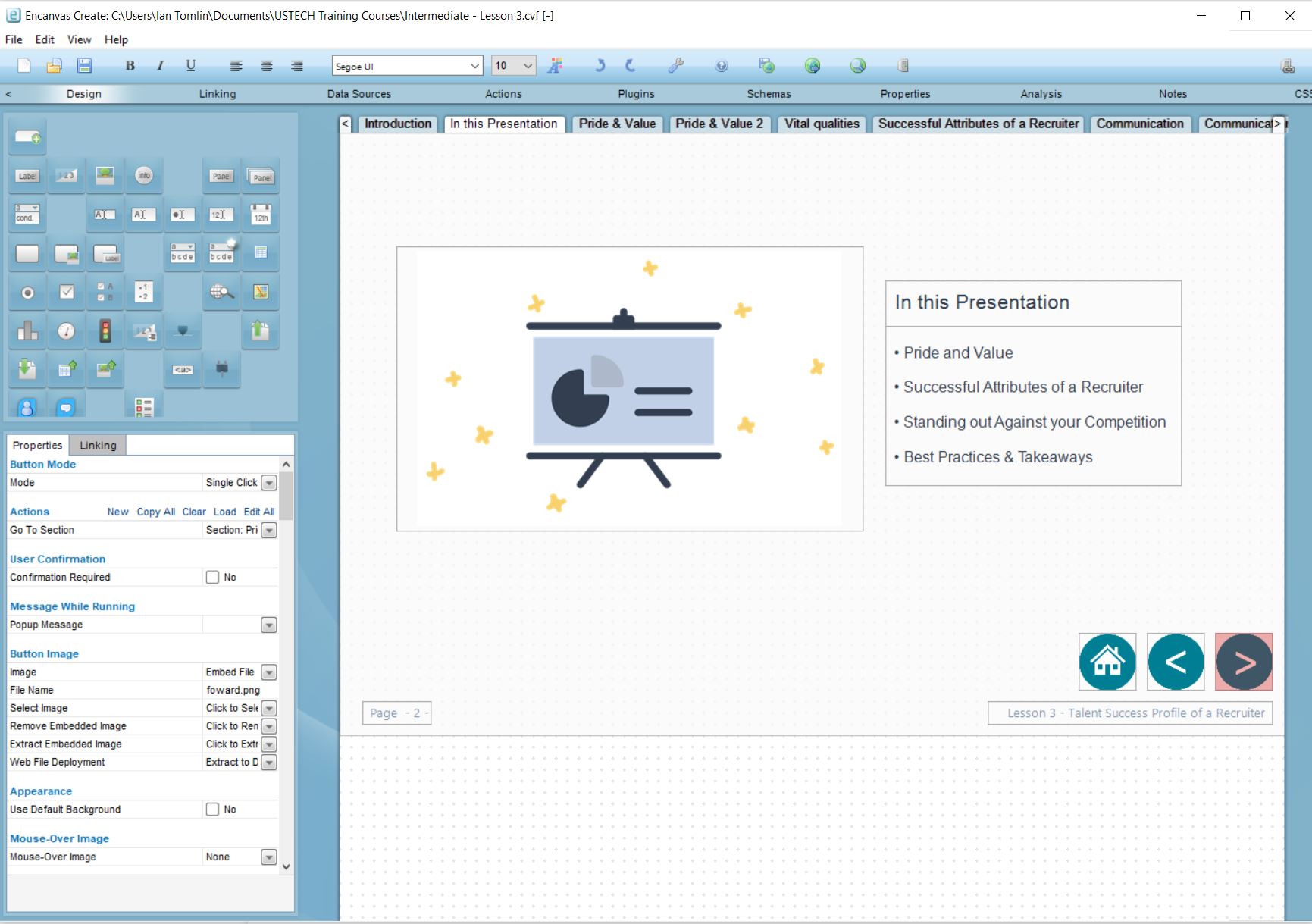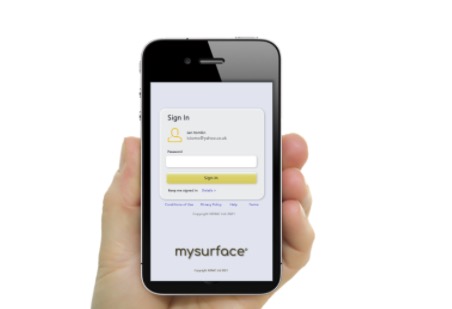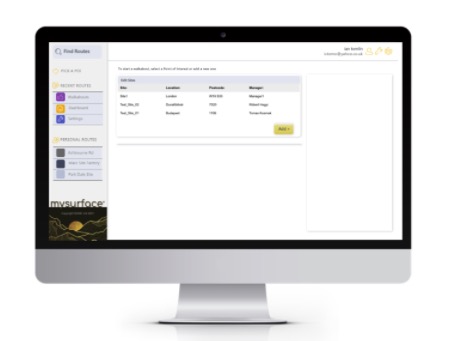EXPERIENCE ENCANVAS IN 60-MINUTES!
We're always happy to walk you through Encanvas no matter where you are in the world.

Codeless web development software removes the need for manual coding of software apps and, in doing so, cuts the time and cost of software development by as much as 60%.
Codeless software is a short-form term to describe a software development approach that removes the visibility of software code from screens when programming software applications. An abstraction layer is used to create applications logic, data structures and forms using software wizards and building blocks. While No-Code platforms allow software developers to quickly build applications by a simple drag-and-drop tool, codeless software goes a step further by eradicating visibility of software code in the software development and publishing journey.
This new form of rapid application development software is today frequently used in web development and enterprise computing. Normally, Low Code and No-Code app development platforms used for codeless authoring are deployed on a cloud computing environment. They help organizations to bring new software applications to market faster, and at a lower cost.
Examples of codeless web deveopment screens (copyright Encanvas 2022). Note the absence of any visible code.


Markets have always been competitive, but with the progressive rise of digital business and the globalization of markets, the very structure of markets is changing too. It means that organizations must find faster and smarter ways to adapt their enterprise computing platforms to maximize customer value and minimize spend. It’s not just people and processes, but technology too is having to adapt faster and more often to change.
This means traditional IT platforms are being displaced by Low Code or Codeless enterprise software application platforms that are designed to adapt to change constantly, and offer productivity enabling tooling to serve the needs of change managers orchestrating change.
At one time, an organizational change was a rare thing. Business models rarely altered and the structure of organizations – i.e. how organizational structures were designed and resourced – had no need to change. Once people were assigned roles in the organization, they rarely moved beyond their role or department. Not today. The business models organizations operate are changing frequently and rapidly.
This is because, in a digital age, the structure of markets and the nature of competition. Many new forms of competition emerge from beyond the traditional players in any given market. We are seeing retailers selling holidays, telecoms contracts and financial services products, utilities and automotive manufacturers selling data and online retailers selling everything! In such a tumultuous market for products and services, suppliers have to respond to change faster. This means organizations are facing near constant organizational restructuring.
Markets have always been competitive, but with the progressive rise of digital business and the globalization of markets, the very structure of markets is changing too. It means that organizations must find faster and smarter ways to adapt their enterprise computing platforms to maximize customer value and minimize spend. It’s not just people and processes, but technology too is having to adapt faster and more often to change.
This means traditional IT platforms are being displaced by Low Code or Codeless enterprise software application platforms that are designed to adapt to change constantly, and offer productivity enabling tooling to serve the needs of change managers orchestrating change.
Codeless software development is a major breakthrough in the evolution of enterprise computing because, until its arrival, enterprise-grade applications were largely created by expert software development teams in back-offices, working ‘offline’ as opposed to developments carried out in near-real-time in workshops.
Evidence shows that users and stakeholders of applications are very much put off by the visual presence of code and script on computer screens as it’s a language they simply don’t understand. In consequence, they feel isolated and unqualified to present their case for enhancements to applications designs during review meetings; some claiming they feel awkward presenting ideas for improvements because of concerns over the amount of extra work they might be placing on IT colleagues.
Codeless web development software is sponsoring a new talent market, as non IT professionals can enter into a career of developing professional applications.
Examples of mobile and web desktop applications developed using codeless programming


The last decade has seen the gradual erosion of centralized IT power in technology selection and decision making. This is partly because departmental leaders have grown more confident in their appreciation of technology and its potential to automate their processes. It is also because read-to-deploy Business Intelligence, Software-as-a-Service (SaaS) applications and robotic process automation (RPA) tools have made it possible for departmental managers to request software tooling that instantly works to address task fulfilment challenges.
During the period, the term ‘citizen developer’ has arrived in enterprise software development vernacular. A Citizen Developer is someone who wants to author an application but lacks IT expertise (particularly coding or scripting) and tools. A wave of Low-Code and Codeless software applications have evolve to aid citizen developers in their quest to use software applications to solve their individual or team productivity challenges.
Codeless web development software platforms equip citizen developers with the tools they need to design applications without coding or scripting, to then deploy apps using one-click deployment methods.
This latest genre of technology raises the bar on what can be achieved by citizen developers. Toolkits enable non-programmers to build complete end-to-end business applications, deploy them, and manage them. This means enterprise-grade apps can be designed and deployed by non-IT people without compromizing IT governance and security.
For some individuals, citizen development codeless software offers the potential of a new career by offering services to businesses through task portals live Fiverr and TopTemp to build apps without coding.
Codeless software has endured a challenging evolution to gain credibility for being useful and professional. In this section, we look at the pro’s and con’s of adopting codeless app development methods.

Sited benefits of using Codeless applications development platforms include:
Adoption of Low-Code and Codeless applications development software used to be seen as a high-risk venture. IT teams were concerned about a loss of influence, control and governance over deployed systems. Fortunately, modern enterprise applications software platforms carefully balance the needs of citizen developers with the expectations of IT teams, so everyone gains. Deployed applications bring MORE INFLUENCE, CONTROL AND GOVERNANCE to IT teams, not less. This is because:
• They are able to respond to the long-tail of demand from departments for new situational applications; removing calls for two-speed IT solutions and dedicated ‘rapid development’ DevOps teams.
• Use of ‘enterprise-grade’ applications development tools removes the existence of self-authored applications such as spreadsheets (so-called ‘shadow systems’ because their existence is unknown to IT teams).
• Furthermore, it means any created data becomes visible to IT and data security governance professionals rather than being held by users on local hard-drives (so-called ‘shadow data’).

Ian Tomlin is a management consultant and strategist specializing in helping organizational leadership teams to grow by telling their story, designing and orchestrating their business models, and making conversation with customers and communities. He serves on the management team of Encanvas and works as a virtual CMO and board adviser for tech companies in Europe, America and Canada. He can be contacted via his LinkedIn profile or follow him on Twitter.
Now read:

Agile Codeless is a software development life-Cycle *(SDLC) approach that embraces codeless authoring methods and tools to produce enterprise apps. Developed by NDMC Consulting over a decade of enterprise software projects, it removes the barriers that exist between IT and the Business when authoring enterprise applications software.
A level of trial and error can be expected for any creative activity but the excessive risks of software authoring are born out in studies both in terms of slow time to market and burgeoning costs. The article ‘Why Your IT Project May Be Riskier Than You Think’ by HBR (November 2011) followed a survey of 1,471 IT projects with an average spend of $167m and found:
Though the pitfalls of software applications development are by now well documented the IT industry has been singularly unable to overcome them. But as globalization increases apace, business models change ever more rapidly and organizations seek to leverage ‘Big Data’, the need to reliably produce better applications right-first-time has never been more critical.
For a hundred years management thinking has valued mechanization over creativity…
..but after decades of automation, the core business processes of organizations are pretty slick – that is until markets change and business models need to realign. Then concepts of operational excellence evangelized by management consultants sound hollow.
As the very structure of markets change, smaller, more nimble companies benefitting from closer ties to their customers, and a clearer understanding of their value, are able to steal a march on vendors 100 times their size.
Even global brands aren’t safe – new aggressors can emerge from a different industry altogether to take a big bite out of a market they see as fair game in an open, global market-place (such as retailers venturing into the car insurance market for example).
“Institutionally, the ability to be agile enough is the gut issue in leading an organization today.” James McNearney – CEO, Boeing
Organizations that could once survive without reviewing business models more than once a decade are now forced to re-assess annually. The new mantra of business excellence is agility – to create an enterprise that can adapt to always win in its most addressable markets.
Key to the drive for agility is the need to empower middle managers; people with the energy, skills and curiosity to question why processes work as they do and find new ways to distil customer value. Leaders are coming to realize that leadership at all levels of the enterprise is vital. This critical tier of ‘corporals’ demand systems and tools to understand and adapt their assets and resources to fit internal processes to the ever changing business landscape.
This is driving demand for a new tier of applications that harvest data from existing sources to create new applications that response to new situations (‘situational applications’) as they arise and align IT systems to better fit constantly evolving processes.
Disparate silos of data across the enterprise – a known problem that has faced organizations for decades, but how do you fix it?
Services-Oriented Architecture is a term that describes the design and use of information services to support business needs; a coherent enterprise-wide method of organizing how computer systems present information to other systems so the data they manage can be accessed more easily without compromising systems performance or security. For business people, the major benefit of organizing information through SOA is the prospect that data held in disparate silos across the enterprise can be re-used to create new applications that produce smarter processes.
To consume Web Services requires applications able to bring data together while fashioning new data structures, web portals and forms-based applications to view, edit and update data.
Demand for these new applications increasingly comes from communities of workers that, while small in number, are essential to process innovation and creativity – things that create competitive advantage in the 21st century business world.
The conceived wisdom of building large lumbering enterprise applications for the majority at the expense of the few, no longer fits the reality of what these critical communities of information workers either need or expect. The high quality of software people now use in their homes and on their mobile phones has raised the bar of what business users expect. The digital native generation dismisses applications that require a manual or that ask them to live with inhospitable reporting tools.
To meet the demands of this new ‘consumerized’ user community, the only viable solution is to produce applications at a faster pace and at lower risk; getting new applications to market faster, at lower cost. This demand has led to the innovations found in the Agile Codeless methodology.
“Middle managers spend more than a quarter of their time searching for information necessary to their jobs, and when they do find it, it is often wrong.”
Source: AIMS survey on information management, 2007
Services-Oriented Architecture is a term that describes the design and use of information services to support business needs; a coherent enterprise-wide method of organizing how computer systems present information to other systems so the data they manage can be accessed more easily without compromising systems performance or security.
For business people, the major benefit of organizing information through SOA is the prospect that data held in disparate silos across the enterprise can be re-used to create new applications that produce smarter processes.
To consume Web Services requires applications able to bring data together while fashioning new data structures, web portals and forms-based applications to view, edit and update data.
Demand for these new applications increasingly comes from communities of workers that, while small in number, are essential to process innovation and creativity – things that create competitive advantage in the 21st century business world.
The conceived wisdom of building large lumbering enterprise applications for the majority at the expense of the few, no longer fits the reality of what these critical communities of information workers either need or expect. The high quality of software people now use in their homes and on their mobile phones has raised the bar of what business users expect.
The digital native generation dismisses applications that require a manual or that ask them to live with inhospitable reporting tools. To meet the demands of this new consumerized user community, the only viable solution is to produce applications at a faster pace and at lower risk; getting new applications to market faster, at lower cost.
Agile Codeless is a rapid method of designing and deploying situational applications for workgroups and teams. It’s codeless because applications are authored using a platform that supplies pre-formed building blocks of technology, negating the need to see or use programming code. The absence of code and script in design workshops is important because it removes the barriers between IT experts and business professionals responsible for scoping applications; probably because they are stakeholders and users of the app to be authored.
The ability to develop applications in near real-time (largely during workshops with users and stakeholders) not only makes applications ‘better-fit’ to the community of users and beneficiaries they’re intended for, but reduces the time, cost and risk of applications developments – all but removing testing, tuning and re-working costs.
Agile Codeless methods and tools dramatically reduce the skills needed for authoring applications which means that one individual can reasonably discharge the entire lifecycle. The fact that applications are authored ‘faster’ does not remove the need for quality gates or pre-qualification of the use-case, user needs and benefactor outcome expectations. Developments are by necessity heavily pre-scoped using formalized analysis methods that include:
Encanvas is an enterprise software company that specializes in helping businesses to create above and beyond customer experiences.
From Low Code to Codeless
Better than code-lite and low-code, we created the first no code (codeless) enterprise application platform to release creative minds from the torture of having to code or script applications.
Use Encanvas in your software development lifecycle to remove the barrier between IT and the business. Coding and scripting is the biggest reason why software development has been traditionally unpredictable, costly and unable to produce best-fit software results. Encanvas uniquely automates coding and scripting. Our live wireframing approach means that business analysts can create the apps you need in workshops, working across the desk with users and stakeholders.
When it comes to creating apps to create a data culture and orchestrate your business model, there’s no simpler way to instal and operate your enterprise software platform than AppFabric. Every application you create on AppFabric adds yet more data to your single-version-of-the-truth data insights. That’s because, we’ve designed AppFabric to create awesome enterprise apps that use a common data management substrate, so you can architect and implement an enterprise master data management plan.
Encanvas supplies a private-cloud Customer Data Platform that equips businesses with the means to harvest their customer and commercial data from all sources, cleanse and organize it, and provide tooling to leverage its fullest value in a secure, regulated way. We provide a retrofittable solution that bridges across existing data repositories and cleanses and organizes data to present a useful data source. Then it goes on to make data available 24×7 in a regulated way to authorized internal stakeholders and third parties to ensure adherence to data protection and FCA regulatory standards.
Encanvas Secure and Live (‘Secure&Live’) is a High-Productivity application Platform-as-a-Service. It’s an enterprise applications software platform that equips businesses with the tools they need to design, deploy applications at low cost. It achieves this by removing coding and scripting tasks and the overheads of programming applications. Unlike its rivals, Encanvas Secure&Live is completely codeless (not just Low-Code), so it removes the barriers between IT and the business. Today, you just need to know that it’s the fastest (and safest) way to design, deploy and operate enterprise applications.
Learn more by visiting www.encanvas.com.
Ian Tomlin is a management consultant and strategist specializing in helping organizational leadership teams to grow by telling their story, designing and orchestrating their business models, and making conversation with customers and communities. He serves on the management team of Encanvas and works as a virtual CMO and board adviser for tech companies in Europe, America and Canada. He can be contacted via his LinkedIn profile or follow him on Twitter.